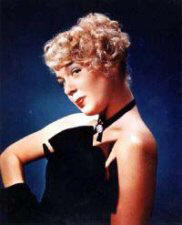|
In Remembrance: Betty Hutton
Born Betty June Thornburg on February 26, 1921 in Battle Creek, MI, Hutton began singing at the age of five in her mother’s speakeasy, after her father abandoned the family. Her family, consisting of Hutton, her sister and mother, eventually settled in Detroit where Hutton continued to sing in bars and night clubs. She was eventually spotted by orchestra leader Vincent Lopez, who hired to perform with his band.
In 1939, Hutton made her film debut, appearing in several Vitaphone musical shorts – three of which featured her with the Lopez Orchestra - shot at Vitaphone’s Manhattan studios. At the same time, Hutton caught the eye of Broadway producer Buddy DeSylva, who cast her in productions of Panama Hattie and Two For The Show. When DeSylva became a producer at Paramount, he signed her to a contract at the studio.
Hutton’s first feature film was the musical comedy The Fleet’s In (1942) which featured Dorothy Lamour, William Holden and the Jimmy Dorsey Orchestra. She was then featured in a series of musicals including Happy Go Lucky (1943) with Mary Martin and Dick Powell and And The Angels Sing (1944), re-teaming with Lamour. In 1944’s Here Comes The Waves, Hutton played twin sisters who forsake their nightclub act to join the Navy’s Waves. The studio also placed her in the musical shorts Strictly G.I. (1943) and Headline Bands (1946).
Hutton’s first headlining role came with Preston Sturges’s classic 1944 comedy The Miracle Of Morgan’s Creek, in which she played a young woman who finds herself pregnant after impulsively marrying and not being entirely sure as to whom the father is. Although censors had concerns over the film’s plot, it was a huge success.
Although the studio would continue to star her in such musicals as The Stork Club (1945), where she played a hat-check girl at the famed Manhattan nightclub, Hutton would also appear in three biopics- Incendiary Blonde (1945), in which she played Texas “Tex” Guinan, the Queen of the Night Clubs, The Perils Of Pauline (1947), about silent-serial star Pearl White and Somebody Loves Me (1952) about Blossom Seeley.
In 1950, Hutton was loaned out to MGM to replace an ailing Judy Garland in the lead of the big screen adaptation of Irving Berlin’s Broadway musical Annie Get Your Gun.
Following 1952’s The Greatest Show On Earth and Somebody Loves Me, Hutton left Paramount Studios following a dispute over whether her then-husband Charles O’Curran should be her exclusive director. She went to work headlining in nightclubs until in 1954 she told a Las Vegas audience that she was retiring from show business. Her retirement lasted only a year, however, and Hutton was back in nightclubs. In 1959, she starred in the eponymously titled The Betty Hutton Show on the CBS television network. The show failed to find an audience and she would make only a few guest appearances on various television series afterwards.
Hutton made one final film after she left Paramount, 1957’s Spring Reunion. |
